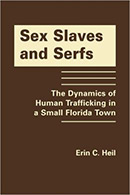Sex Slaves and Serfs: The Dynamics of Human Trafficking in a
Small Florida Town

Author: Erin C. Heil
Publisher: Boulder, CO: First Forum Press, 2012. 169p.
Reviewer: Kathleen Powell | March 2013
To the average person, the term ‘human trafficking’ typically invokes a mental image of women held captive in grungy, clandestine brothels in countries across the world. This imagery presents common misconceptions about human trafficking; author Erin C. Heil attempts to debunk these myths in her new book, Sex Slaves and Serfs: The Dynamics of Human Trafficking in a Small Florida Town. The machinery of human trafficking necessitates secrecy in order to avoid interdiction, resulting in uninformed public opinion about the characteristics and prevalence of the problem across the world. Heil aims to raise awareness about the incidence of human trafficking in America by cataloging her findings from a two-year case study in the small agricultural town of Immokalee, Florida. Previously described as a ‘hotbed’ for human trafficking, the author uses Immokalee to serve as an exposé of the crime across America. Although this argument’s validity can be debated, the study’s findings unmask much of the mysterious interaction between the relevant actors involved in human trafficking. Sex Slaves and Serfs follows a logical structure; it first distinguishes between types of human trafficking, then describes the work of local law enforcement and interest groups, and concludes with recommendations for future action against the crime.
Heil begins by making the important, yet sometimes neglected distinction between two subdivisions of human trafficking. She first discusses the labor trafficking industry, which is extensively present in Immokalee because of the town’s agriculturally based economy. Heil then writes about her observations of Immokalee’s commercial sex economy, which coincides with the town’s labor trafficking market. The author argues that these two industries are inextricably intertwined, as the presence of one breeds the necessity for the other. In both instances, victims are subject to tremendous intimidation from their oppressors, leaving them extremely fearful to attempt any remedies to their situation. This argument is crucial to fostering understanding of trafficked victims, as they are often publically perceived as voluntarily entering such subcultures.
Next, the author describes efforts taken by local law enforcement and community groups to assist the victims. By conducting the study at a micro-level over an extended period of time, Heil was able to gain precious insight into these efforts and learn of the various constraints that hinder their success. Despite their good faith, the author points out that these groups, and others similarly situated across the country, are often faced with impediments that severely curtail the success of their endeavors. Aptly titled “Effecting Change”, Heil addresses these concerns in the final chapter of the book, where she summarizes her findings and suggests actions for change.
Overall, Sex Slaves and Serfs presents a nearly complete picture of human trafficking from the perspective of Immokalee, Florida. The book successfully sheds light on the unknown elements of trafficking through anecdotal evidence, personal observations, and limited official data. Confusing legislation, covert transactions, and misconceptions about victims are presented as common reasons for the public’s ignorance and prejudice towards these offenses. To counter this, Heil presents the raw experiences of these victims, challenging the stereotypes and preconceived notions that may be held by the public. Sex Slaves and Serfs provides microscopic insight into a crime that is widely prevalent, yet still largely unknown to the general public.
Kathleen Powell, Graduate Student, University of Pennsylvania


